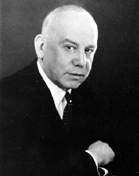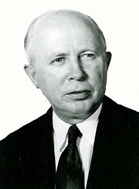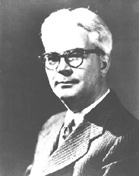Consolidation Period
Coalition of 1932
During the period of the Great Depression, it became more and more difficult to sustain three distinct visual instruction organizations. After several rounds of negotiations, in 1932 the three (NAVI, VIAA, and DVI) merged into one, maintaining the DVI identity. This watershed event in the organization’s history was known as "the coalition of 1932.”
Growing Membership and Leadership Burdens
During this period the membership was growing from a couple of hundred to over 600 by the start of World War II. Still, the harsh economic conditions prevented the NEA from assigning staffing specifically to DVI, meaning that the presidents and secretary-treasurers found themselves burdened with virtually a full-time job. This was a constant source of frustration.
Members and officers continued to accept these responsibilities with missionary zeal, motivated by the belief that students were hindered in their learning by teaching that was abstract, sterile, and limited to verbal representation. The antidote was to infuse teaching with more active experiences and more richly visualized presentations, as indicated by the title of the leading textbook of that era, Visualizing the Curriculum (Hoban, Hoban, and Zisman 1937). As Charles Hoban, Jr. reminisced some forty years later:
The battle then as now was against verbalism, except that then the issues were more clearly seen and drawn. Verbalism was words empty of concrete, acted-upon, psychologically transformed meanings of reality as experienced through the senses…. The 1920s and ‘30s were the days when our bag of tools were the school journey or field trip, the object, specimen, and model, the glass slide, and the 10- or 15-minute teaching film…(AECT, 1973, p. 22).
The term "missionary zeal” is quite appropriate to the reality of the times. The small core of enthusiasts tended to act very much as promoters, accepting every opportunity to persuade recalcitrant educators to change their traditional ways.
Helping Teachers Integrate Media
By the mid-1930s training pre-service teachers to use the new media and helping in-service teachers integrate mediated materials into their lesson plans became major emphases of DVI, not unlike the experience with the new computer technology some 50 years later. The most popular topics in visual instruction courses in 1932 were: philosophy and psychology of visual instruction, motion pictures, lantern slides, projector operation, stereographs, photographs, exhibits, and field trips.
At colleges and universities—as at schools—the collections of slide and film equipment and materials were growing to the point that it became necessary to make policy decisions about how to house, distribute, and maintain them. Many institutions decided to establish centralized services. This created a demand for staff with specialized professional skills—the director of visual education services, which became the core constituency of DVI.
 The 1930s began with school people being chosen as president but ended with college people becoming the more dominant figures:
The 1930s began with school people being chosen as president but ended with college people becoming the more dominant figures:
- 1932-1933, Charles F. Hoban, director, State Library and Museum and Director of Visual Instruction for the state of Pennsylvania (the father of Charles F. Hoban, Jr., who would later become a leader of the association himself)
- 1933-1934, Grace Fisher Ramsey, curator, School Relations, American Museum of Natural History, New York City
- 934-1935, Wilbur Emmert, director, Film Library, State Teachers College at Indiana, Pennsylvania
- 1934-1937, Nelson L. Greene, Publisher and Editor, The Educational Screen, Chicago (two terms)
- 1937, Rupert Peters, director, Visual Instruction, Kansas City schools, was elected at the convention, but he resigned because of illness and was succeeded by the first vice-president, Edgar Dale, a professor of curriculum at Ohio State University.
Constitution of 1941
 When Edgar Dale assumed the presidency (1937-1938), he initiated an overdue reconsideration of the constitution, leading to the drafting of two new constitutions in the next four years. The changes were generally aimed at Dale’s desire to increase the membership, provide more democratic representation, and to parcel out the burden of official work. With the new constitution of 1941, the association instituted a zonal organizational plan, creating ten geographic zones, each with a president, who would be a member of the executive committee.
When Edgar Dale assumed the presidency (1937-1938), he initiated an overdue reconsideration of the constitution, leading to the drafting of two new constitutions in the next four years. The changes were generally aimed at Dale’s desire to increase the membership, provide more democratic representation, and to parcel out the burden of official work. With the new constitution of 1941, the association instituted a zonal organizational plan, creating ten geographic zones, each with a president, who would be a member of the executive committee. In the 1940s the membership dues were $2 (in addition to membership in the NEA), which included a subscription to the commercially published periodical, The Educational Screen. The dues were approximately evenly divided among the Ed Screen publisher, the zonal administration, and the central administration. This symbiotic but rather informal arrangement with Ed Screen lasted into the 1950s.
Issues
One specific technology-pedagogy issue that was hotly debated in this period was the desirability of using the new technology of sound recording to create sound educational films in place of the traditional silent ones. This was not the "no-brainer” that one might think looking backward. Silent film advocates pointed out the value of teachers’ adding their own narration to the film as it was shown. This not only personalized the film for the specific audience but also integrated the teacher into the presentation. The issue was hotly debated at the 1936 convention and in other venues. Research and pedagogical theory supported the teacher-narrated silent film, but eventually the force of sheer commercial momentum settled the issue in favor of "talkies.”
DVI participated in the lobbying effort to establish 16mm motion picture film as the standard for educational use. Around the same time, the association supported federal action to reserve a band of the radio spectrum for non-commercial broadcasting. The Federal Communications Commission, created in 1934, responded with a set of reservations in 1938 and another in 1945. DVI was not a leading force in the radio arena, as few of its members had a primary affiliation with broadcasting. Their responsibilities began at the point teachers or professors actually used radio programs in the classroom.
The standardization of terminology was another recurring issue as new technological developments continued at an accelerating pace. By 1937, "visual instruction” was becoming obsolete, as radio and other audio sources became available in schools. Although the label "visual-auditory” had crept into some DVI publications by this time, the term "audio-visual” prevailed by the mid-1940s. Technological advances were constantly raising semantic challenges, so committees were established regularly in the late 1930s and early 1940s to meet and issue recommendations on terminology.
 The presidents immediately following Dale were also university affiliated, but during the war years leadership was in the hands of public school audiovisual administrators:
The presidents immediately following Dale were also university affiliated, but during the war years leadership was in the hands of public school audiovisual administrators:
- 1938-1939, Rita Hochheimer, assistant director, Bureau of Visual Instruction, University of Wisconsin extension division.
- 1939-1940, John E Hansen, chief, Bureau of Visual Instruction, University of Wisconsin extension division.
- 1940-41, Paul C. Reed, director, Department of Visual and Radio Education, Rochester, NY city schools
Enforced Dormancy during World War II
US involvement in World War II required increasing national mobilization, including rationing of scarce resources and curtailing non-defense travel. Camilla Best, who was head of the Department of Audio-Visual Aids for Orleans Parish schools in New Orleans, took office as president in 1942 and held the office for three terms. No large conventions were allowed to be held (although the NEA Representative Assembly was allowed to meet), and since the association was essentially a convention-activity-only type of organization, it was essentially dormant for the remainder of the war years.
Unless specified otherwise, all material on this site is © 2001 by AECT
Association for Educational Communications and Technology
1800 N. Stonelake Dr. Suite 2
Bloomington, IN • 47404
877-677-AECT
812-335-7675
Contact:
Association for Educational Communications and Technology
1800 N. Stonelake Dr. Suite 2
Bloomington, IN • 47404
877-677-AECT
812-335-7675
Contact: